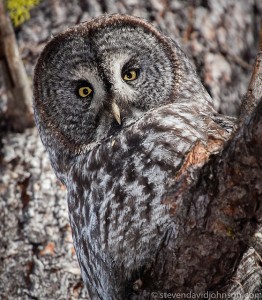Some environmentalists hold rallies. Some file lawsuits.
Steven David Johnson takes photographs — then puts them to work.
Johnson practices conservation photography, creating images with an aim of affecting environmental change.
“It’s combining, or marrying, nature photography with environmental advocacy,” said Johnson, 42, of Broadway in the Shenandoah Valley.

Johnson has provided pictures for people trying to save rare salami-sized salamanders, called hellbenders, to people trying to gain extra protections for parts of mountainous western Virginia, and to people opposing a natural gas pipeline that would run through National Forest land in Augusta County.
And, oh, what pictures (view his Flickr album). In underwater closeups, salamander eggs look like planets wrapped in gauzy halos. A tree’s roots look like octopus tentacles. Amorous newts look as if their cold blood runs hot. A Shenandoah River beaver looks as if it has slicked back its hair for a date. It just goes on.
“I can say, without question, that Steve is one of the emerging talents in nature and conservation photography,” said Clay Bolt, a Bozeman, Mo., conservation photographer and president-elect of the North American Nature Photography Association. He has known Johnson for several years.
“Conservation photography” is a relatively new term in environmentalism, but the practice goes back decades. Think of Ansel Adams, who photographed the American West while fighting for wilderness protection during a 60-year career in the 20th century.
“However, a photo of a wild place alone – as beautiful as it may be – without any action is simply a beautiful photo of a beautiful place,” Bolt said.
Johnson said a conservation photographer has to have “a mission to preserve the natural world.”
Johnson teaches what he preaches. At Eastern Mennonite University in Harrisonburg, where he is an associate professor of visual and communication arts, Johnson founded a one-semester course in conservation photography in 2013.
Johnson grew up in rural Houghton, N.Y. Probably like a lot of conservation photographers, he said, he developed a love of the outdoors as a child.
“For me, it was wandering out in the hills and streams of western New York. I also fell in love with photography. … So this seemed like a natural way of giving back to places that nurture me, which are wilderness, the outdoors, the streams and rivers of the Northeast and now Virginia.”

Johnson and his wife, Anna Maria, chose their Rockingham County home largely because it’s near the North Fork of the Shenandoah River, a frequent photography subject. The couple has two daughters, Eliza, 14, and Magdalena, 12.
Johnson, who holds a master’s degree in fine arts from the Savannah College of Art and Design, is chair of Eastern Mennonite’s Visual and Communication Arts and Theater Department.
Johnson and his family are Mennonites, a Christian faith that espouses nonviolence, service to others and care for God’s creation. Although it has many non-Mennonite students, Eastern Mennonite teaches from a Mennonite perspective.
“I operate from a tradition that sees stewardship of the Earth and its resources as important,” Johnson said.
The term “creation” is often used by people, called creationists, who reject evolution. Johnson made clear that he accepts that long-established tenet of science.
“The relationship between evolution and biodiversity is one of the things I find most fascinating about the natural world, and collaborating with biologists is one of my favorite conservation photo activities.”
Lynn Cameron, a Rockingham environmentalist and co-chair of a group working to get extra protections for a Shenandoah Mountain tract in western Virginia, said photos by Johnson and his students have helped the cause.
“His pictures are just so compelling, and they really help people appreciate the beauty, and especially the biodiversity, of Shenandoah Mountain,” Cameron said.
Chris Bolgiano, a Rockingham nature writer, is president of the Virginia Wilderness Committee, a conservation group. Johnson is a board member and has provided photos to the group.
Whether Johnson is photographing rare salamanders or national forest land that might be affected by the proposed Atlantic Coast pipeline in Augusta, Bolgiano said, “He has a bigger vision than just a pretty nature photo.”
Jim Norvelle, a spokesman for Dominion Transmission Inc., which is leading the pipeline effort, said he didn’t know Johnson and declined to comment on his work. But Norvelle said the pipeline, if approved, would be buried and “practically invisible.”
“The objective is to find the best route with the least impact on the environment, historical and cultural resources,” Norvelle said.
Although Johnson is an advocate for the environment, he said he doesn’t manipulate his images beyond normal adjustments, such as cropping and controlling contrast.
“If there is a telephone wire in the middle of my picture, there is a telephone wire in the middle of my picture,” he said.
Johnson said his advocacy is reflected more by what he chooses to shoot, whether it’s a mountain landscape or a fish kill in a river.
“I don’t think it’s all about showing beauty,” Johnson said.
What it’s about is moving the public to care for the creation that’s so dear to Johnson’s work and life.
Reprinted with permission from the Richmond Times-Dispatch, Sept. 19, 2015
